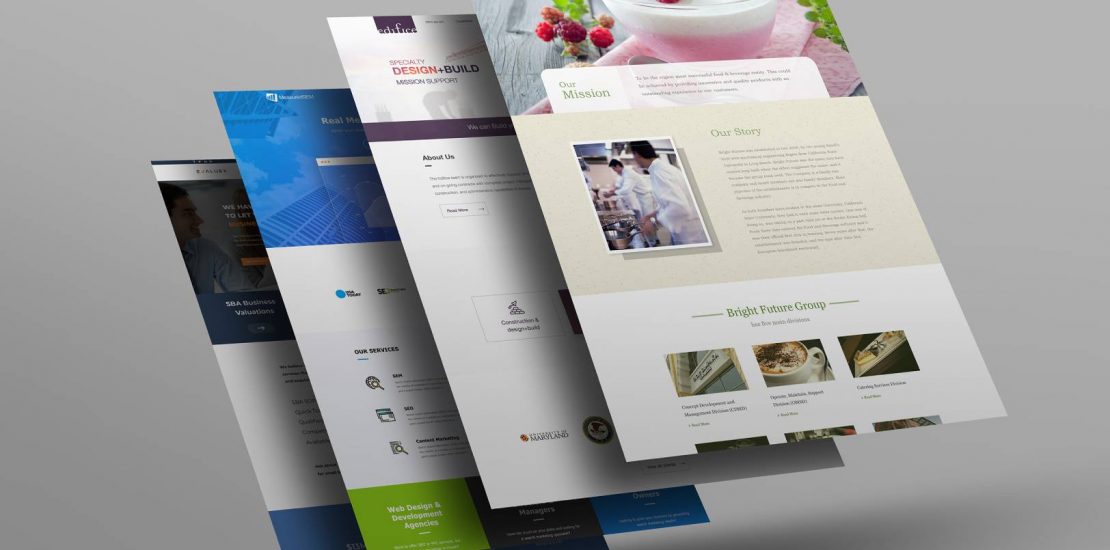Follow our easy guide to ensure your website is the best tool for both your marketing goals and your customers’ needs. A website should nurture potential customers through the like, know, trust phase of customer acquisition.
Take It From The Top: Why A Good Website Is Crucial For Success
A great website includes a well-developed home page, a well-populated interior site, and efficient use of web technology.
Your website is the first impression a customer has on your brand, the ball is in your court to effectively capture their interest. Think of your site as the cradle in the Like, Know, Trust portion of your customer’s journey.
First and foremost, your homepage is your moment to capture your audience. Your customer should be greeted by an aesthetically cohesive site, as well as be able to easily discern your core message, find a solution to their problem, trust your product, and contact information. It is important to make a good first impression with your website visitors and captivate them with your content.
What Makes A Great Homepage?
A Small Business website’s home page should include: your brand’s core message or promise, your brand story, the benefits of your service, trust elements, visual elements, contact information, and a call to action.
Your homepage is like a first date between your business and a potential customer. If you want to score a second date (or a potential sale) be sure to have your brand’s core message, benefits of your service, trust elements, a method of contact, and your page graphics dressed in harmony with your branding. Follow this easy 7-step process to improve your site.
1. Convey Your Core Message, Brand Promise, and Story: You Are the Magician!
When someone visits your website, they are looking for an answer to a problem. Your core message should communicate the problem and method of your solution.
The customer wants to get to ‘Know’ you. Located at the top of your page, your message should be clear, concise, and engaging to make the guest stay and learn more. Instead of saying, ‘From our family farm to your kitchen,’ instead consider ‘Providing the freshest, heirloom produce with a simple and dedicated delivery.’
An easy way to check your message (and promised solution) is to be aware of what questions your customer will ask along the decision-making process. When telling the story of your brand you have the opportunity to be the hero, teacher, and magician. Your service and support should flow and echo through the website.
2. Showcase The Benefits of Your Core Product Or Service As “The Solution”
The solution to the customer’s problem is the product or service you provide. Introduce your core offerings by highlighting the benefits of what you can provide, not just what you’re selling.
What frustrations does the consumer have and what do you provide to put their mind at ease? This is an opportunity to tap into the emotional aspect of the ‘Like’ and ‘Trust’ of the customer journey. For example, if you have four services provide four short descriptions that are benefit-driven. Tease out details that showcase convenience, comfort, and advantages to lead your customer to move to internal pages.
By delivering clear benefits you take the guesswork out of the problem-solving stage; a customer knows what to expect and how the story ends.
3. Why Should I Buy From You? Elements to Establish Trust.
When a customer finds your website, building trust is crucial to reinforcing why they should ‘buy in’ with you. Furthermore, a potential lead is more likely to trust another source than just your brand promise, which they should already know.
Easy ways to build confidence and credibility are:
- Logos – Have you sold your products to Michelin Star Restaurants? Logos of your past and present customers are a signal of longevity and establish credibility.
- Testimonials – Positive testimonials and five-star reviews let your prospects know your solution is worth investing in and allow them to learn from another source.
- Videos – A short video gives the customer an avenue to see for themselves what you have to offer, can signify your qualifications, and gives an intimate “hands-on” introduction.
- Honors, Awards, Articles – Were you voted ‘Best Of’ in your category of service in the local news? Did you receive an award for sustainability or community service? Showcase how you stand out from the competition.
4. Dressed For The Customer’s Interview: Visual Branding
In the age of drag-and-drop website building, you don’t have to start from scratch to build a beautiful, concise landing page. However, like getting dressed for an interview, you want to consider the aesthetic portion of your branding.
Here are some key questions to ask yourself when building your website:
- Are my fonts, colors, and formatting consistent?
- Are my images high quality and clearly represent the brand?
- What are my competitors doing that I can use and make better?
5. Clear Contact Information Translates to: ‘We Want To Hear From You!’
The homepage you’ve built has your customer interested–by providing clear contact information where they can reach out with the click of a button. Maybe they are ready to visit your brick-and-mortar store and need the address or have a question that can be answered by phone or email. Is it easy to find? Open the door to welcome a potential customer.
The best place to have your contact information is at the header and footer of your webpage, as well as a ‘Contact’ link in the top bar of your site. Your business name, address, and phone number should be at the top of your page. At the bottom of your page in addition to the aforementioned crucial contact information, you can add your social media accounts. In the header bar, a ‘Contact’ link will lead the consumer to an internal page dedicated to contacting your business. Here, include more information such as a map that highlights parking, or embed a place for the customer to send your business a question directly. Contact information might seem like a no-brainer, but it is a crucial step to your website’s success.
6. Creating a Call to Action:
A Call to Action (CTA) is a mix of copy and graphics, usually a button, that invites the visitor to develop their relationship further. This is the next step in your customer’s journey. A CTA is intended to increase conversions, but the homepage is still the ‘Like, Know, Trust’ portion of your customer’s journey, not the ‘Buy’.
An example of a CTA can be a subscription to a newsletter, a piece of valuable downloadable content, or a free consultation/tour. The CTA should be clear, direct, and help to guide the customer toward your business in their buying decision. This is an essay way to capture information like names and email addresses, which can then be followed up with marketing materials and included in Customer Relationship Management software.
A CTA provides something of value to your customers, and in exchange builds brand trust and your list of potential leads. Start with a simple CTA and adjust accordingly to reap the benefits of the website you’ve built.
7. You’ve Built It So Be Sure They Come: Search Engine Optimisation
Search Engine Optimization (SEO) might seem daunting, but getting started is easier (and less expensive) than you might’ve been led to believe. A customer’s search begins and ends in a search box, so help that engine lead them to you.
When building the content of your website, be mindful of what terms and solutions your ideal customer is searching for. Optimize your content by enriching your descriptions with these terms and phrases. By utilizing your content to best answer consumer queries you are signaling to search engines that your website is the place to find an answer.
In Conclusion
Your webpage should go beyond conveying your core message and solution to a consumer’s pain point. A small business website can become a powerhouse; it can express your problem-solving methods, provide content valuable to your customer, showcase previous work and testimonies to build trust, and compel your customer to provide their information with you.






